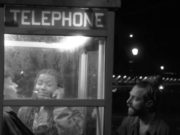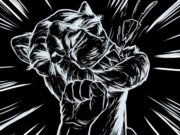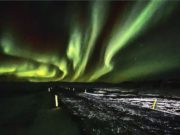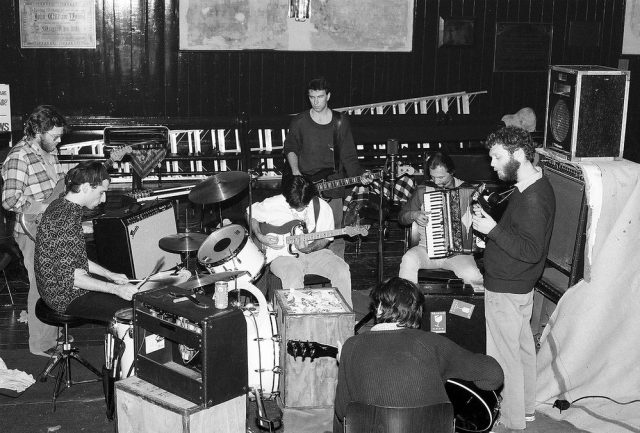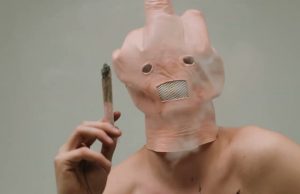 I am pretty certain I couldn’t make the music I do in a traditional studio setting. You know, the control room which looks out into or over a studio space where musicians work with producers and/or engineers to get their best takes recorded digitally or on tape.
I am pretty certain I couldn’t make the music I do in a traditional studio setting. You know, the control room which looks out into or over a studio space where musicians work with producers and/or engineers to get their best takes recorded digitally or on tape.
My process involves me editing multiple takes into a single good one. This is something which would be considerably less enjoyable if I was anxious and self-conscious about some wiser-in-the-ways-of-music producer or engineer watching me. Judging me. Figuring out how full of shit I am. And all the while I’m responsible for paying for every second of time it takes to struggle my way through songs which haven’t been properly fleshed-out yet.
No way. No sir. I couldn’t hack a traditional studio setting. Simply put, I haven’t got the chops and I have ADHD. That means it’s unlikely that I’ll ever be prepared. So when I hear about bands who have recorded albums not only in a studio with loads of lookers-on, but have done so live to tape — I can’t help but be more than a little impressed.
Live to tape (or live off the floor) means the band plugged in, got mic’d up or whatever and simply recorded the songs as though it were a live performance. Audio verité. Van Halen worked like this on their first few records. You can tell because when Eddie is doing a guitar solo, there’s no rhythm or secondary guitar — just bass and drums.
Now, don’t get me wrong — I love crazy studio manipulation records. I’m a big psychedelic and prog guy at heart, but I find live-to-tape stuff pretty exciting. It’s like the difference between the Alfred Hitchcock films Psycho and Rope. Psycho is a heavily-edited cinematic masterpiece, loaded with symbolism and carefully crafted scenes. Rope was shot like a play on a set, and only has 10 edits in the whole movie. And really, that’s because film reels only held 10 minutes of footage. Half of the film’s 10 edits were done sneakily, too — with someone or something filling the camera lens in the foreground so you don’t even see the edit. Rope is a whodunnit, and the long, editless scenes really help build tension.
This is how I feel about live-to-tape records. Besides, when making a crazy, multi-tracked psychedelic epic, it really helps to have a solid, reliable drum track throughout — even just for editing. Just ask The Beatles. Ringo Starr hardly did any retakes and never played to a click track, yet all The Beatles songs are pretty easy to edit and splice because the drums are bang-on. Seems like a good place to start: The Beatles, but instead I’m going to try to steer clear of stuff recorded prior to 1970, when live-to-tape recording wasn’t all that unusual.
Canadian alt-country band Cowboy Junkies did their 1988 album The Trinity Session live around a single mic (except for the vocals), as you you can see in the picture at the top of this column. As the album title hints, it was recorded inside Toronto’s Church of the Holy Trinity on a single day in late November, 1987. The album produced a pretty popular track — their cover of The Velvet Underground song Sweet Jane.
In order to access the church, the band lied about who they were, claiming to be The Timmins Family Singers (which was sorta true, I guess) who intended to record a Christmas album (which was definitely not). The production equipment was kept to a minimum: For tape stock and a recorder, they used a Sony Betamax SL-2000 video cassette deck with a single Calrec ambisonic microphone plugged in, via a digital/analog converter.
For his third studio album, Tom Waits and producer Bones Howe wanted to make something that sounded like a live album. Unable to find a suitable venue, they decided to make their own in one of The Record Plant studios in Los Angeles. They brought in tables, invited a small audience and rounded up musicians to learn the new songs. Nighthawks At The Diner was recorded there, like a live album — direct to tape — on the last two days of July 1975.
Nick Drake not only recorded his final album, 1974’s Pink Moon, solo and live to tape in a single weekend — but he also did the more complex Five Leaves Left live to tape. He sat with his guitar in the middle of a string ensemble, recording five songs in three hours. By my rules, this album doesn’t count — it came out in 1969. But, the idea of sitting on a stool in the middle of a string ensemble and tracking live is too cool not to be included.
I do have to leave out some of the lo-fi acts I know and love — like Guided By Voices, Daniel Johnston, Palace, Sentridoh / Sebadoh and the first few Folk Implosion albums. I’m more interested in albums with which you might be surprised to discover were recorded live off the floor.
For example, after making two heavily edited and overdubbed albums, Radiohead sought to make a much more live-sounding album in the fall of 2002. Their sixth effort, Hail To The Thief, was recorded in Los Angeles in a fashion similar to putting on a play, according to frontman Thom Yorke. Using computers to integrate electronic elements into the music, they recorded much of the record live as a band, which took a great deal of rehearsals. For example, the opening track 2+2=5 only took two hours to complete. Hail To The Thief wasn’t without overdubs — which were done later in England, along with album mixing — but nothing like previous albums.
Belle And Sebastian’s debut album Tigermilk was recorded almost entirely live in a Glasgow recording studio over three days in June 1996. Surprisingly, the band were incredibly green and hadn’t really played together much before this. Nine of the album’s ten songs were done live. The only one that wasn’t is Electronic Renaissance, which was a home recording transferred to a cassette tape. The version heard on the album is a recording of this cassette being played by a Glasgow radio station. Art!
David Bowie relocated to Sigma Sound in Philadelphia in the summer of 1974 to record his first post-glam album Young Americans. Due to Bowie’s legendary cocaine intake — and the fact that the songs were recorded “85% live” according to producer Tony Visconti — they managed to finish much of the album in just two weeks. A second series of sessions took place in New York in the fall of ’74 and again in early 1975.
Arctic Monkeys spent the better part of January and February 2011 in L.A. recording their fourth album Suck It And See. From the outset they aimed to record it mostly live and therefore did extensive rehearsals. Only a handful of overdub sessions were required.
The Stooges’ sophomore album, 1970’s Fun House, was an attempt to make an album which captured the energy and power of the band’s live show. So they basically did a live show — but at Elektra Sound Recorders studio. The band set up in their stage formation and plowed through the songs over and over, with the best versions chosen for the album. You can hear the whole process on 1970: The Complete Fun House Sessions, a giant box set that chronicles the entire affair from start to finish.
Some artists take the live-to-tape concept out of the studio and on the road. Jackson Browne recorded much of his landmark 1977 live album Running On Empty in hotel rooms, on tour buses and backstage at venues. Canada’s own Great Lake Swimmers routinely record in a variety of unconventional locations — castles, churches, abandoned grain silos and even caves. They didn’t work in an actual studio until they made their fifth album.
Here’s one of the coolest stories of live-off-the-floor purism: John Mellencamp’s 2010 album No Better Than This. Mellencamp recorded the album at a series of historic locations across the U.S. while on tour with Willie Nelson and Bob Dylan playing minor league baseball parks. One such location was Room 414 of the Gunter Hotel in San Antonio — where Delta blues legend Robert Johnson recorded his first session in November 1936. Mellencamp also recorded at Sun Studios in Memphis and the First African Baptist Church in Savannah, which claims to be the first black congregation in the States.
At these locations, Mellencamp recorded using the same simple setup every time: He and the other musicians would gather around a single mic, plugged into a 1955 Ampex portable tape machine — in mono. It’s the same setup the blues singers used in the ’30s and ’40s. Mellencamp wanted to record at the former Brunswick Records building in Dallas, where Johnston did his final session in 1937. He was denied by the building’s owner.
He should have known that authority always wins.
• • •
Area Resident is an Ottawa-based journalist, recording artist, music collector and re-seller. Hear (and buy) his music on Bandcamp, email him HERE, follow him on Instagram and check him out on Discogs.







